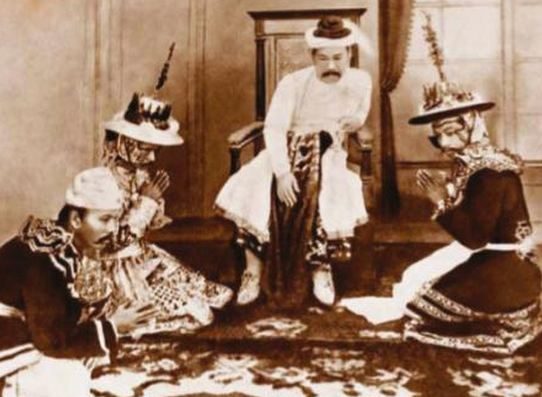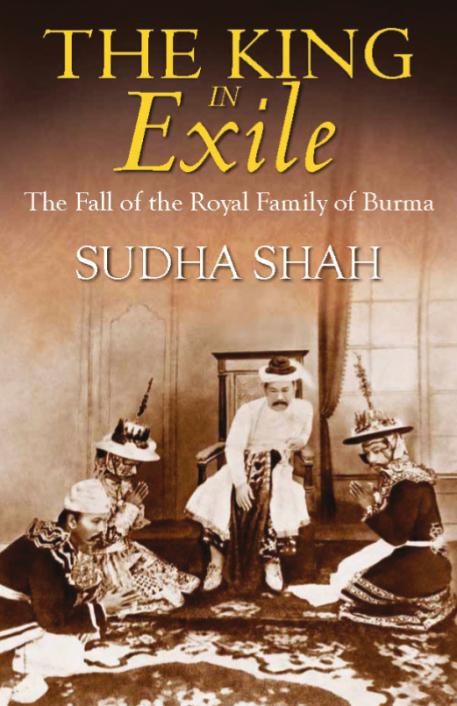Sudha Shah, The King in Exile: The Fall of the Royal Family in Burma
New Delhi: HarperCollins Publishers, 2012. Pp. xxiii, 456; glossary of names, genealogical table, photographs, appendices, notes, bibliography, index.
Reviewed by Donald M. Seekins.
Intrinsically, the biographies of the founders of dynasties, royal or otherwise, are worth reading. These founders may not be particularly sympathetic figures, but each of them indisputably launched something big. King Alaungpaya (r. 1752-1760)–founder of the Konbaung dynasty, Burma’s last royal house–was a tyrant who is said to have massacred 3,000 Buddhist monks after capturing the Mon capital city of Hanthawaddy (modern Pegu or Bago) in 1757. Alaungpaya, whose family were local gentry in Upper Burma, claimed descent from both the Maha Thammada, the First King who was said in Buddhist legend to have been chosen by the people to establish the first state, and from the Sakyas, the northern Indian clan into which Gotama Buddha was born. But, to borrow Napoleon’s words, such characters do not have ancestors, they are ancestors.
Most dynasties begin with a bang, but end with something closer to T. S. Eliot’s now proverbial whimper. This was certainly true of the Konbaung dynasty. After firm though not unchallenged rule under the penultimate Konbaung monarch Mindon (r. 1853-1878), whose domain was limited to Upper Burma after the British annexed Lower Burma in 1852, King Thibaw (r. 1878-1885) stumbled into war with the colonizers in late 1885. The royal capital of Mandalay was occupied by British Indian troops, the palace built by Mindon looted both by courtiers and by the British (with British officer Colonel Sladen accused by some Burmese of making off with the king’s magnificent Nga Mauk Ruby), and Thibaw’s realm, together with Lower Burma, absorbed into the British Indian empire. Burma remained under foreign rule (including the 1942-1945 Japanese occupation) until January 1948, when the Union of Burma was established – as a republic.
The British could have kept a Konbaung monarch on Burma’s throne as a figure head, much as they did in the princely states of India and in the Shan and Karenni principalities of colonial Burma’s Frontier Areas. But among the surviving royal princes no adequate successor to the (in their eyes) treacherous, cruel and incompetent Thibaw could be found, and so the monarchy was abolished. The British sent Thibaw into exile in India along with his headstrong queen Supayalat and their daughters.
Sudha Shah’s The King in Exile is well written and exhaustively researched. The book’s source materials include over sixty letters and interviews with people who knew the exiled royals first-hand, all acquired by the author. Shah details the often unhappy lives of Thibaw, Supayalat, their four daughters and their grandchildren, starting with a description of palace life both before and during the time Thibaw reigned and during their lives as prisoners of the British in a not-so-golden cage in exile in Ratnagiri, a small town on the west coast of India, in what was then the Bombay Presidency. After Supayalat returned to Burma (where she was obliged to reside in Rangoon rather than the old royal city of Mandalay) after the death of her husband in 1916, she lived quietly but earned the deep respect of Thakin Kodaw Hmaing, a nationalist writer and ardent royalist who was probably the single most important literary figure in modern Burmese history. The queen and the writer are interred next to each other in large tombs in Rangoon’s Kandawmin Park, south of the Shwedagon Pagoda. Unfortunately, the author does not tell us much about the interactions between the ex-queen and the noted writer, or how his relationship with Supayalat might have informed his ideas on Burma’s national identity.
British policy toward the royal family after 1885 focused on the need to prevent its members from becoming rallying points for anti-colonial nationalism. This focus explained both their exile to a distant corner of India until Supayalat’s repatriation in 1919 and the fostering of their dependency on the colonial government through stipends, stipends sometimes reduced with little or no explanation. The goal of the colonizers seems to have been to make Thibaw and his family dependent without giving them real financial security, as through a steady income. Much of the book discusses the royals’ complaints to the colonial government concerning reductions in their allowances. In a sense, these allowances betrayed a contradiction in British policy: there no longer was, officially, a Burmese royal house, but the government nevertheless compensated Thibaw, Supayalat and their descendants, even if inadequately.
Though not without talent or intelligence of their own, Thibaw’s and Supayalat’s four daughters, the princesses, were not encouraged to acquire a modern education of the kind which would have given them an opportunity to make their own way in the uncongenial twentieth-century world. Of the four princesses, only the Second Princess (1881-1956), made a real life for herself. She lived with style if not substance with her Burmese husband Lathakin, an ardent nationalist, in Kalimpong, a town in the high Himalayas. The most tragic royal child was her elder sister, the First Princess (1880-1947), who alienated her mother by marrying an Indian, B. S. Gopal–a household servant in Ratnagiri. Ms. Shah points out frankly that Gopal was more interested in the First Princess’s government stipend than in her welfare. Though much beloved by local people for her kindness and generosity, she died in poverty in Ratnagiri a quarter-century after returning there from Burma in 1920.
The author provides a handy genealogical table (following p. xxiv) for those readers, probably most readers, who become confused by royal names and the plentitude of royal descendants. The major shortcoming of The King in Exile is the author’s failure to link the Burmese royals’ lives with larger developments in their country under colonial and post-colonial rule. Indian readers may be interested in the royals’ connection with their own country during their time in exile, but Ratnagiri was (and remains today) so far off the beaten track that, apart from this family’s residence there, it was a place of little importance. Although generally sympathetic, the royals are not individually or historically very interesting characters. Thus, the many details of their biographies can be tedious simply because of their ordinariness.
However, the reason for the historical unimportance of the royal family may, in itself, be of interest. According to William Koenig, the concept of Burmese kinship contained two important elements. One was the idea of an exclusive royal lineage, which not only led Alaungpaya to claim the most distinguished of ancestors but also legitimized intermarriage among half-siblings to preserve “purity” of royal blood. The second element was “karmic” legitimacy, the king’s amassing of merit over many lifetimes which qualified him to occupy the throne. A sovereign who through evil deeds – or, perhaps, just plain mediocrity – squandered his abundance of merit would lose his throne. As Koenig describes it, “Kingship went unquestioned, but individual kings did not” (1990, p. 84). No Burmese ruling house was sacred; kingship depended upon the ebb and flow of kamma. From this, it follows that, while members of the Burmese public under British rule may have had a sentimental fondness for the royal family, the family did not possess in their eyes any (residual) right to rule. Significantly, Aung San Suu Kyi’s father Aung San expressed his opposition to a monarchical restoration.
One hundred and thirty years after the fall of the Konbaung Dynasty, Burma or Myanmar will hold general elections for the Hluttaw (national legislature) in 2015, elections in which it is possible that Aung San’s daughter, long in opposition, may gain a position of national leadership. Lineage, co-joined with courage and ability, still matters in Burmese politics, but no man or woman claiming Konbaung ancestry plays a significant role in the country’s politics today. The King in Exile is the story of a dynasty that belongs truly to Burma’s past.
Donald M. Seekins is the author of The Order in Disorder: The Army State in Burma since 1962 (2002), Burma and Japan Since 1940: From “Co-Prosperity” to Quiet Dialogue (2007), and State and Society in Modern Rangoon (2011).
Reference
William Koenig. The Burmese Polity, 1752-1819: Politics, Administration, and Social Organization in the Early Kon-baung Period. Ann Arbor: Center for South and Southeast Asian Studies, University of Michigan, 1990.
 Facebook
Facebook  Twitter
Twitter  Soundcloud
Soundcloud  Youtube
Youtube  Rss
Rss 
